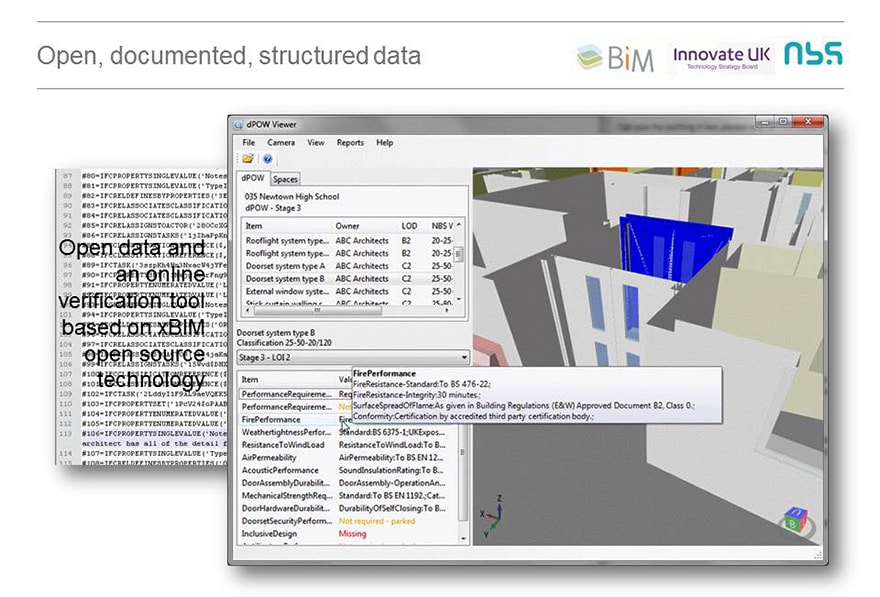The BIM world is to get an early preview of the NBS Digital Toolkit for Level 2 BIM projects, due for launch this April, at a series of “roadshow” events at the eight regional BIM Hubs in February and March.
In addition, NBS will be holding a series of webinars in late February to introduce the system to a wide audience.
The Digital Toolkit is a free-to-use online service that allows BIM model data to be uploaded, then checked to ensure it has right level of geometric detail and technical information.
The project will deliver the Digital Plan of Work, one of the final pieces in the suite of standards and systems that make up the government’s definition of Level 2 BIM.
The south-east and London BIM hubs, chaired by CIC regional BIM champions John Eynon FCIOB and David Miller RIBA of David Miller Architects, are collaborating on a combined event.
Both had recently attended presentations given by the NBS team, and pronounced themselves impressed with the emerging service, which will consist of several software tools and a classification system for products and systems.
Eynon told BIM+: “They showed us a presentation of how the tool works and what it could do – it looks very positive. It’s a work in progress, and when they do launch it, there will be more work to do. But it was pretty impressive.”
And Miller said: “It’s obviously one of the missing pieces in Level 2 BIM, and I think it’s the one that will get people very excited. It makes a lot of what we’re trying to do understandable and accessible, that’s why we’re particularly excited about the opportunity to show the progress so far.
“It will provide a road-map of how to approach the project, setting out who does what, when, so I think it should have very wide appeal, and make things a lot more straightforward for the industry’s mainstream.”

The Digital Toolkit is a free-to-use online service
Clare Watson, director of marketing at NBS, commented: “The Digital Toolkit is being developed for the whole industry to use and benefit from. It’s vital, therefore, that we engage with the broadest representation as is possible. NBS and its partners is committed to making the tool work for all disciplines and sectors; that includes the new pan-industry classification, the definitions of level of detail and information, product templates and the digital plan of work.
“In addition to the support and guidance we are getting from our pan-industry institute advisory group [which includes the CIOB and other members of the C8 group of institutes], we are also inviting other organisations, groups and institutes to be involved, give feedback and keep their members up to date on how this free set of tools will benefit them.
“The BIM Hubs were an obvious choice to help us coordinate regional events to allow construction professionals from across the UK to see the progress on the project and give us their feedback. We are delighted to have their support and look forward to hosting the event with them.
Anyone not able to attend the events themselves can also keep up to date by visiting www.thenbs.com/bimtoolkit where they can see articles, watch videos and see other events at which we are presenting the project. They can also sign up to one of a series of webinars on 25, 26 and 27 February where Stephen Hamil, project lead, will give an overview of the toolkit and a taste of the project so far.
Anne Kemp, chair of ICE’s BIM Action group, said: “ICE’s aim is to develop and support the world’s best digitally-enabled civil engineers and provide thought leadership and direction to the way BIM is implemented throughout the industry. We are delighted therefore to be playing a part in developing a modern, relevant digital tool which facilitates a more consistent approach across the industry.
“We look forward to continuing this collaborative work with NBS and its partners, as well as the other institutions and professional bodies, helping to ensure the tool reaches – and is embraced by – all those at the forefront of BIM.” Kemp is also head of BIM at Atkins and newly-appointed deputy chair of BuildingSMART UK.
Although it has been described as a “compulsory” element of Level 2 BIM for government-funded projects, the BIM Task Group’s David Philp indicated at the BIM+ debate that its use would be recommended rather than a requirement.











